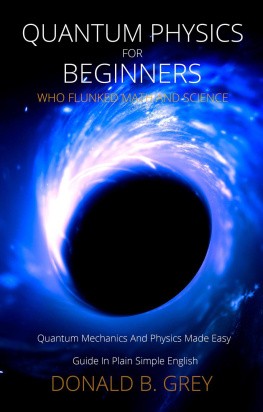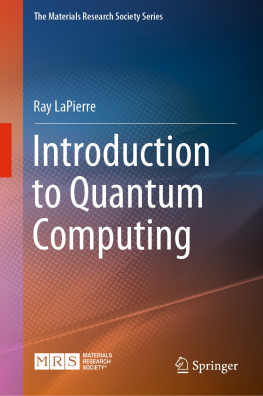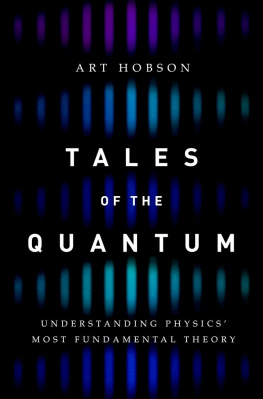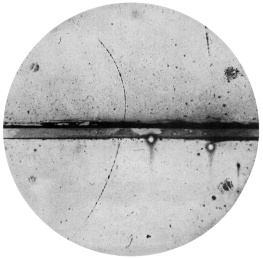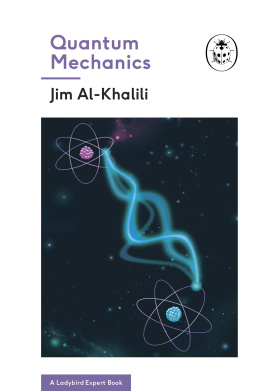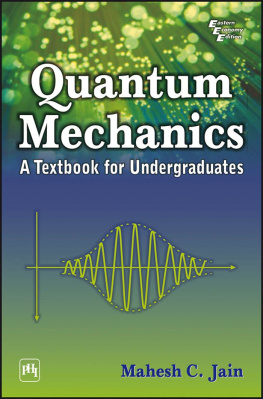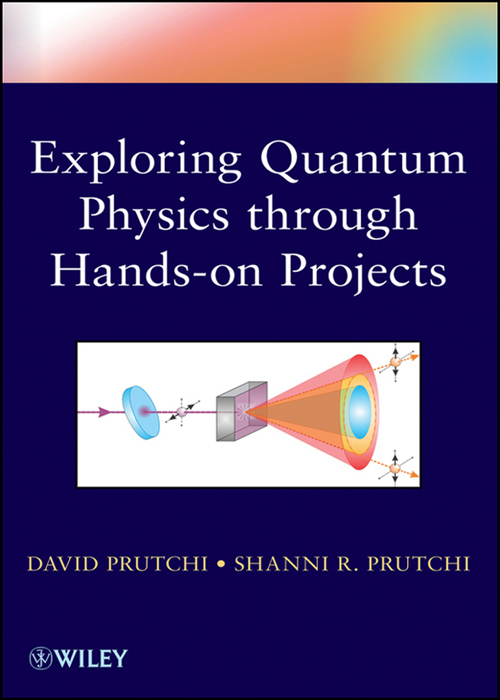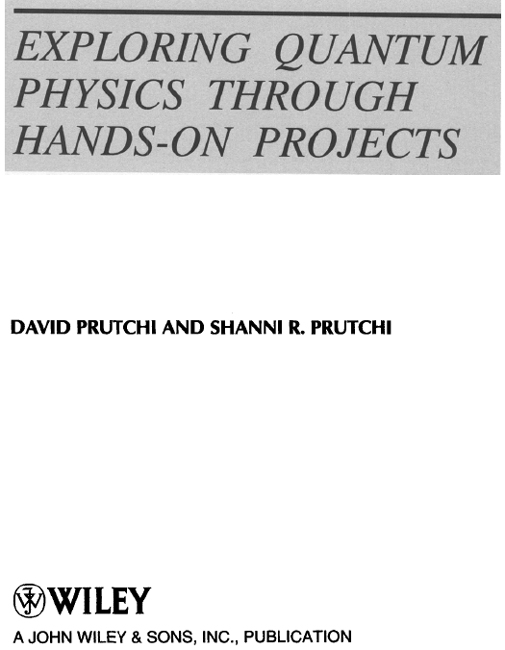EXPLORING QUANTUM PHYSICS THROUGH HANDS-ON PROJECTS
Copyright 2012 by John Wiley & Sons, Inc. All rights reserved
Published by John Wiley & Sons, Inc., Hoboken, New Jersey
Published simultaneously in Canada
No part of this publication may be reproduced, stored in a retrieval system, or transmitted in any form or by any means, electronic, mechanical, photocopying, recording, scanning, or otherwise, except as permitted under Sections 107 or 108 of the 1976 United States Copyright Act, without either the prior written permission of the Publisher, or authorization through payment of the appropriate per-copy fee to the Copyright Clearance Center, Inc., 222 Rosewood Drive, Danvers, MA 01923, (978) 750-8400, fax (978) 750-4470, or on the web at www.copyright.com . Requests to the Publisher for permission should be addressed to the Permissions Department, John Wiley & Sons, Inc., 111 River Street, Hoboken, NJ 07030, (201) 748-6011, fax (201) 748-6008, or online at http://www.wiley.com/go/permission .
Limit of Liability/Disclaimer of Warranty: While the publisher and author have used their best efforts in preparing this book, they make no representations or warranties with respect to the accuracy or completeness of the contents of this book and specifically disclaim any implied warranties of merchantability or fitness for a particular purpose. No warranty may be created or extended by sales representatives or written sales materials. The advice and strategies contained herein may not be suitable for your situation. You should consult with a professional where appropriate. Neither the publisher nor author shall be liable for any loss of profit or any other commercial damages, including but not limited to special, incidental, consequential, or other damages.
For general information on our other products and services or for technical support, please contact our Customer Care Department within the United States at (800) 762-2974, outside the United States at (317) 572-3993 or fax (317) 572-4002.
Wiley also publishes its books in variety of electronic formats. Some content that appears in print may not be available in electronic format. For more information about Wiley products, visit our web site at www.wiley.com .
Library of Congress Cataloging-in-Publication Data:
Prutchi, David.
Exploring Quantum Physics Through Hands-On Projects/David Prutchi and Shanni R. Prutchi.
p. cm.
Includes index.
ISBN 978-1-118-14066-6 (pbk.)
1. Quantum theoryPopular works. 2. Quantum theoryExperiments. 3. Science projects.
I. Prutchi, Shanni R. II. Title.
QC174.12.P785 2011
535.15dc23
2011030360
In memory of Zeide Simon.
Dedicated to Saba Shlomo, Savta Ruthi, Babbe Rosmari,
Dorith, Hannah, and Abigail.
Introduction
Tell me and I forget. Teach me and I remember. Involve me and I learn.
Benjamin Franklin
Physics developed steadily after the introduction of Isaac Newtons ideas in the 1600s and had made great progress by the nineteenth century. People really felt the impact of this knowledge when the Industrial Revolution was made possible by the application of everything that scientists had learned about mechanical forces, gravity, electricity, magnetism, heat, light, and sound.
By the late nineteenth century, scientists felt that all of this understanding of physics formed a framework that could describe the world very deeply and thoroughly. Still, there were some nagging inconsistencies between theoretical calculations and experimental data, which were acknowledged by Lord Kelvin (who formulated the First and Second Laws of Thermodynamics) in his 1900 lecture titled Nineteenth-Century Clouds over the Dynamical Theory of Heat and Light. The two dark clouds to which he was alluding were the unsatisfactory explanations that the physics of the time could give for the constancy of the speed of light, as well as for the glow produced by a hot body.
What is now known as modern physics was born from the two major physical theories that were developed during the twentieth century to resolve these two dark clouds: for the former, the Theory of Relativity; for the latter, quantum mechanics.
The shift caused by modern physics was dramatic, because new concepts showed aspects of reality that are completely different from our day-to-day observations. The Theory of Relativity describes how events look very different for two observers who are moving relative to one another. It makes really bizarre predictions about the way clocks tick relative to one another when they move, how objects are measured to be shortened in the direction that they are moving with respect to the observer, and how energy and mass are equivalent (described by the famous equation E = mc2).
Quantum mechanics makes statements that are even weirder than those of relativity. In the odd world of quantum physicsat least as explained through the extreme thought experiments of its original foundersobjects can be in two places at the same time, cats can be both simultaneously dead and alive, and everything that looks continuous to us is really pixelated into tiny, discrete chunks.
In spite of its strangeness, a working knowledge of relativity requires no more than basic algebra and geometry. After all, relativity is just a more fundamental, up-to-date, and accurate version of the classical physics founded by Newton. On the other hand, quantum mechanics is much more difficult to understand. Richard Feynman, a physicist who won the Nobel Prize for his work on quantum physics, didnt believe that anyone really understands what the theory tells us. In his words: I think I can safely say that nobody understands Quantum Mechanics.
Nevertheless, quantum mechanics works so well that it has enabled the development of lasers, transistors, chips, and displays used in the electronic gadgets that are so important to our modern lives. Because of this, quantum physics ought to be an important part of everyones education. However, the math is so complex, and our most intuitive notions about reality are so shockingly wrong, that understanding of this subject has remained largely confined to a select group of physicists and engineers. Unfortunately, this has also led to many popularizations that grossly misguide readers and give them completely false notions about the concepts and implications of quantum mechanics.
In this book we will try a different approach. The idea is to build an intuitive understanding of the principles behind quantum mechanics through hands-on construction and replication of the original experiments that led to our current view of the quantum world. We have developed the experimental setups in such a way that they can be constructed easily and at low cost. In addition, we have worked and re-worked the math, so that it is accessible to anyone with knowledge of high school algebra, basic trigonometry, and, if possible, a little bit of calculus. We want to point out that in spite of the many simplifications that we make, we strive to present a conceptually correct view of quantum physics to those who are not conversant in its highly specialized jargon and formalism.
Our approach comes from the belief that there is a huge difference between knowing about something and actually understanding it. We believe that if one is to understand anything about quantum mechanics, one must first develop a gut feeling about the quantum world, to get past the mystical veil that so tightly wraps its inner workings. We are hands-on tinkerers, so we follow Benjamin Franklins approach toward education: Tell me and I forget. Teach me and I remember. Involve me and I learn.


